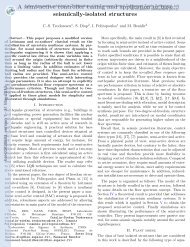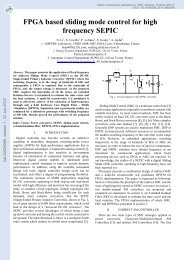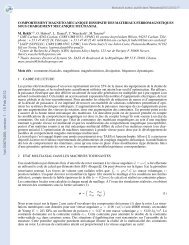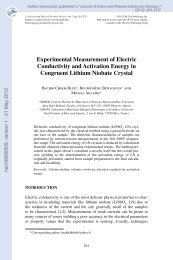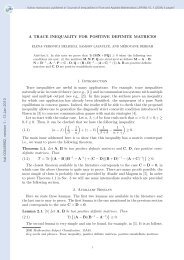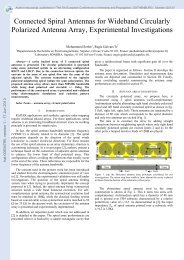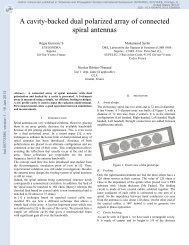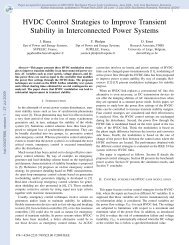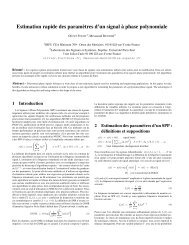Entity Localization and Tracking: A Sensor Fusion-based ...
Entity Localization and Tracking: A Sensor Fusion-based ...
Entity Localization and Tracking: A Sensor Fusion-based ...
Create successful ePaper yourself
Turn your PDF publications into a flip-book with our unique Google optimized e-Paper software.
esults of a simulation run composed by 100 trials, in each ofthem a ME travels from an initial position close to anchorsA1-A4 to one close to A5-A8, similarly to the referencescenario in Fig. 2, following a r<strong>and</strong>om walk, as described inSection V-A. Fig. 3 shows the cumulative distribution of theerror measured by the DTW for all the tracking algorithmsavailable: INS, SD, ESD <strong>and</strong> two SCC fusions, one thatconsiders INS <strong>and</strong> SD <strong>and</strong> the other between INS <strong>and</strong> ESD.Fig. 4(a) shows how the MTi can be connected to a PCthrough the USB-serial adapter, where the sensor outputsare collected. Every sensor measurement is referred to theCartesian system as shown in Fig. 4(b). This reference systemis called S <strong>and</strong> is body-fixed to the device. The orientation ofthe sensors are then computed between S <strong>and</strong> the Earth-fixedsystem (called G), as shown in Fig. 4(c).(a) Scheme <strong>and</strong> interface with the PC.hal-00663057, version 1 - 25 Jan 2012Fig. 3.Cumulative error distributions of the considered tracking methods.From Fig. 3 the following conclusions can be drawn: (i) theINS as a tracking solution alone suddenly shows bad performancebeing really sensible to the high value of σ 1 , σ 2 <strong>and</strong> thepresence of obstacles; (ii) the ESD <strong>and</strong> the SD as independentsolutions show better performance than INS <strong>and</strong> this is mostlydue to the choice of σ di,j with respect to σ ax , σ ay ; (iii) asevidenced in previous work [8], it is confirmed that ESDoutperforms SD in terms of accuracy of the final estimation,<strong>and</strong> (iv) overall, the sensor fusion algorithm improves theperformance of the tracking system.In general, the comparison of SCC(INS,SD) withSCC(INS,ESD) confirms that the key to obtain good trackingperformance is the implementation of efficient algorithmstogether with the use of sensors able to provide very accuratemeasurements. With the help of this MATLAB tool, futurework will include the analysis of the system performance as afunction of parameters, such as σ nẍ, σ nÿ, σ di,j , σ ax <strong>and</strong> σ ay .C. Experimental AnalysisThe encouraging simulation results have been validatedagainst preliminary real experiments using the XSENS MTiMotion Tracker [18]. It is a small-size IMU with a 3D compass<strong>and</strong> an embedded processor able to compute in real-time roll,pitch <strong>and</strong> yaw, as well as the linear 3D accelerations, angularspeed <strong>and</strong> Earth magnetic field.1) XSENS MTi Motion Tracker: The MTi orientation isestimated using a XSENS internal Kalman filter (XKF3) whichfuses the signals from the gyroscopes, accelerometers <strong>and</strong>magnetometers to compute an optimal statistical 3D orientationwith high accuracy. By the XKF3 algorithm, the Earthmagnetic field <strong>and</strong> gravity measurements enable an attitude<strong>and</strong> heading drift errors compensation [18].(b) Coordinates system.Fig. 4.Details of the MTi IMU.(c) Reference system.2) 2D tracking: The Kalman filter <strong>and</strong> DWNA kinematicmodel have been applied to estimate the trajectory of the MTisensor, starting from its acceleration measurements. However,in order to use the Kalman filter, the covariance matrices of thestate <strong>and</strong> the output noises are needed. While the former wascomputed using the whole set of the acquired measurements,the latter was inferred from the nominal noise density valuesreported in the MTi datasheet [18].To simplify the experiment, the MTi device was moved ona table, like a PC’s mouse. By this way, Roll <strong>and</strong> Pitch contributionsare close to zero, then the Earth’s gravity contributioncan be filtered out by simply subtracting the average value ofthe measured accelerations for the x <strong>and</strong> y axes.Fig. 5 shows the reconstructed trajectory of a clockwisemovement of the MTi device along a rectangular shape 6 of10 cm x 8 cm. Interestingly, the system shows very goodperformance in estimating the trajectory for quick movementsof the device, while, as confirmed in [19], for low accelerationvalues the reconstructed trajectory is not satisfactory, due tothe effects of the noise in the measurements.VI. CONCLUSIONS AND PERSPECTIVESIn this work we proposed a positioning <strong>and</strong> tracking system<strong>based</strong> on the fusion of position estimations provided by twodifferent <strong>and</strong> independent techniques. Thanks to the MATLAB6 An experimental campaign is currently on-going at the University ofL’Aquila using the platform in more realistic <strong>and</strong> wider scenarios.
hal-00663057, version 1 - 25 Jan 2012Fig. 5.Example of estimated trajectory.simulator we developed, we are able to assess the performancelimits of the algorithms (i.e., INS, SD, ESD <strong>and</strong> SCC) whenthey are used to estimate the positions of a mobile entity. Simulationresults clearly show the advantage of the integrationof different systems: sensor fusion provides better accuracieswith respect to those provided by each individual algorithmiccomponent, but the best joint performance are dependent onthe accuracy of each individual component.The Kalman Filter built on top of the DWNA kinematicmodel has been tested also using measurement traces acquiredby a real platform, the XSENS Motion Tracker MTi, thatThales Italia made available to the Center of ExcellenceDEWS in L’Aquila (Italy). Preliminary results confirm thegood performance when the movement traces have largeacceleration impulses, while for slow movements, i.e. smallacceleration, the noise level becomes dominant.In the current version of the simulator, the Kalman filterneeds to know the covariance statistic matrices, thus theacceleration measurements must be already available. Thislimits the applicability of the proposed solution in scenariosrequiring hard real-time constraints. On-going work includesthe substitution the INS of the Kalman filter with a faster,but sub-optimal time-<strong>based</strong> algorithm (such as a trajectoryprediction). By this way, the INS system can reset its initialposition estimation, as soon as the SCC detects that the ESDis going to have a better accuracy.Longer term future work will include the development ofrealistic signal propagation models [20] in the MATLAB tool,in order to enable a smoother transition for the ESD amongdifferent WSN-equipped spaces (as in Fig. 2). This will fosternew studies about anchor deployment planning for WSNs,to cope with tracking requirements but with knowledge ofthe new performance limits provided by the sensor fusiontechnology.ACKNOWLEDGMENTThe authors would like to thank the anonymous reviewersfor their constructive comments.The research activity of Stefano Tennina is supported by theEMMON project, funded by National Funds, through the FCT- Portuguese Foundation for Science <strong>and</strong> Technology, undergrant ref. ARTEMIS/0003/2008, as well as by the ARTEMISJoint Undertaking, under grant agreement n. 100036. The workdone by Fortunato Santucci <strong>and</strong> Fabio Graziosi is supported bythe FP7 NoE HYCON2, project number 257462 <strong>and</strong> projectIRMA2 (Ministry of Defense of Italy).REFERENCES[1] A. Goldsmith <strong>and</strong> S. Wicker, “Design challenges for energy-constrainedad hoc wireless networks,” Wireless Communications, IEEE, vol. 9,no. 4, pp. 8 – 27, aug. 2002.[2] M. Dohler, “Wireless sensor networks: the biggest cross-communitydesign exercise to-date,” Bentham Recent Patents on Computer Science,vol. 1, no. 1, pp. 9–25, 2008.[3] J. Bachrach <strong>and</strong> C. Taylor, H<strong>and</strong>book of sensor networks: algorithms<strong>and</strong> architectures - <strong>Localization</strong> in sensor networks, I. Stojmenovic, Ed.Wiley Series on Parallel <strong>and</strong> Distributed Computing, 2005.[4] C. Wang <strong>and</strong> L. Xiao, “<strong>Sensor</strong> localization under limited measurementcapabilities,” Network, IEEE, vol. 21, no. 3, pp. 16 –23, may-june 2007.[5] M. Mauve, A. Widmer, <strong>and</strong> H. Hartenstein, “A survey on position-<strong>based</strong>routing in mobile ad hoc networks,” Network, IEEE, vol. 15, no. 6, pp.30 –39, nov/dec 2001.[6] N. Patwari <strong>and</strong> J. Wilson, “RF sensor networs for device-free localization:Measurements, models, algorithms,” Proceedings of the IEEE,2010.[7] ——, “See through walls: Motion tracking using variance-<strong>based</strong> radiotomography networks,” IEEE on transaction on mobile computing, 2010.[8] S. Tennina, M. Di Renzo, F. Graziosi, <strong>and</strong> F. Santucci, “Locatingzigbee nodes using the ti’s cc2431 location engine: a testbed platform<strong>and</strong> new solutions for positioning estimation of wsns in dynamic indoorenvironments,” in Proceedings of the first ACM international workshopon Mobile entity localization <strong>and</strong> tracking in GPS-less environments,ser. MELT ’08. New York, NY, USA: ACM, 2008, pp. 37–42.[Online]. Available: http://doi.acm.org/10.1145/1410012.1410022[9] J. Hightower <strong>and</strong> G. Borriello, “Particle filters for location estimation inubiquitous computing: A case study,” in In Proceedings of InternationalConference on Ubiquitous Computing (UbiComp, 2004, pp. 88–106.[10] Grewal, Weill, <strong>and</strong> Andrews, Global Positioning System <strong>and</strong> InertialNavigation <strong>and</strong> Integration. Jhon Wiley, 2007.[11] J. Nocedal <strong>and</strong> S. Wright, Numerical Optimization, 2nd ed., Springer,Ed. Springer, 2006.[12] Y. Bar-Shalom, X. R. Li, <strong>and</strong> T. Kirubarajan, Estimation with Applicationsto <strong>Tracking</strong> <strong>and</strong> Navigation. Theory Algorithms <strong>and</strong> Software.John Wiley <strong>and</strong> Sons, 2001.[13] D. Silva, Brancalion, <strong>and</strong> Fern<strong>and</strong>es, “Data fusion techniques appliedto scenarios including ADS-B <strong>and</strong> radar sensors for air traffic control,”12th International Conference on Information <strong>Fusion</strong>, USA, 2009.[14] “Comparison of two measurement fusion methods for kalman-filter<strong>based</strong>multisensor data fusion,” IEEE transaction on aerospace <strong>and</strong>electronic system, 2001.[15] S. J. Julier <strong>and</strong> J. K. Uhlmann, “A non divergent estimation algorithm inthe presence of unknown correlations,” American Control Conference,1997.[16] J. Fern<strong>and</strong>ez-Madrigal, E. Cruz-Martin, J. Gonzalez, C. Galindo, <strong>and</strong>J. Blanco, “Application of uwb <strong>and</strong> gps technologies for vehicle localizationin combined indoor-outdoor environments,” in Signal Processing<strong>and</strong> Its Applications, 2007. ISSPA 2007. 9th International Symposiumon, feb. 2007, pp. 1 –4.[17] G. Li, Y. Wang, M. Li, <strong>and</strong> Z. Wu, “Similarity match in time seriesstreams under dynamic time warping distance,” in Computer Science<strong>and</strong> Software Engineering, 2008 International Conference on, vol. 4,dec. 2008, pp. 399 –402.[18] MT Software Development Kit Documentation, Rev. j ed.,Xsens Technologies, May 2009. [Online]. Available:http://www.xsens.com/en/general/mti[19] A. Jimenez, F. Seco, C. Prieto, <strong>and</strong> J. Guevara, “A comparison ofpedestrian dead-reckoning algorithms using a low-cost MEMS IMU,”6th IEEE International Symposium on Intelligent Signal Processing,2009.[20] O. Ozdemir, R. Niu, <strong>and</strong> P. Varshney, “<strong>Tracking</strong> in wireless sensornetworks using particle filtering: Physical layer considerations,” SignalProcessing, IEEE Transactions on, vol. 57, no. 5, pp. 1987 –1999, may2009.


